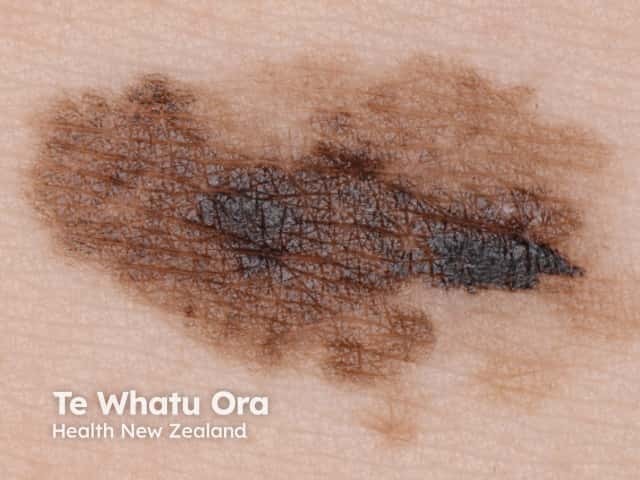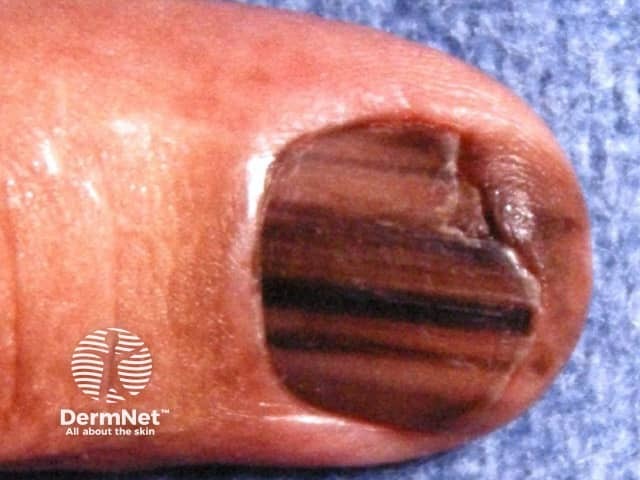Main menu
Common skin conditions

NEWS
Join DermNet PRO
Read more
Quick links
Genes and melanoma — extra information
Lesions (cancerous) Diagnosis and testing
Genes and melanoma
Author: Hon A/Prof Amanda Oakley, Dermatologist, Hamilton, New Zealand, 2011.
Introduction
Genes and UVR exposure
Driver mutations
Genetic inheritance of melanoma
Genes and skin colour
Introduction
Although the main cause of melanoma is the sun, genes are important too. Molecular genetic study of melanoma (genomics) is rapidly increasing our understanding of the disease and how to treat it. It's a very complicated field of research. This page is a short description of why genomics is important.
See also Genetics of melanoma.

Superficial spreading melanoma

Nodular melanoma

Subungual melanoma
Genes are damaged by UVR
Exposure to UV radiation, particularly to UVA (long-wave ultraviolet radiation) causes changes in our melanocyte (pigment cell) genes.
There are likely to be many other triggers to account for the rare forms of melanoma that are not related to sun exposure.
Genetic and chromosomal changes can include:
- Mutations
- Duplications
- Deletions.
Genetic changes might cause the melanocyte cells to:
- Self-destruct
- Grow into a harmless melanocytic naevus (mole)
- Rapidly divide, out of control
- Invade surrounding tissue
- Spread through the blood system or lymphatics
- Induce more blood vessels to grow to feed the melanoma
- Prevent an immune response to the melanoma
There are numerous different genetic alterations in primary and secondary melanoma.
Driver mutations
Common driver or initiating mutations are described below. Understanding driver mutations are leading to new treatments for advanced melanoma.
- Mutant BRAF is found in about 50% melanomas, especially those diagnosed in people under 55 years of age. It is also found in numerous harmless moles. BRAF stops moles growing larger by inducing senescence (old age) and growth arrest in the melanocytes.
- Mutations in NRAS are found in 20% of melanomas.
- c-KIT alterations are reported in some melanomas arising on the soles of the feet, under the nails and in mucous membranes.
- GNAQ and GNA11 mutations are associated with melanoma in the eye.
- No driver mutations are found in about one-third of melanomas.
Genes explain familial melanoma
Some families are said to have familial melanoma, which is due to mutations in genes that are passed down from parent to child and may be associated with clinically atypical naevi and pathologically dysplastic naevi. Melanoma caused by inherited genes is suspected if two or more first-degree relatives (parent, brother, sister or child) are diagnosed with melanoma.
Several specific mutations have been described in different families with melanoma. About 40% have mutations in the CDKN2A gene. Affected members of families with this abnormality tend to have many large moles.
Genes explain skin colour
Skin colour partly depends on the activity of the melanocortin 1 receptor (MC1R) gene.
- People with greater MC1R activity have black/brown eumelanin and tan easily on exposure to UVR.
- People with minimal MC1R activity have red hair and fair skin, due to red/yellow phaeomelanin pigment.
- Phaeomelanin blocks UVR poorly compared to eumelanin, so people with red hair and fair skin are at the highest risk of developing melanoma.
Interferon regulatory factor 4 gene also is a melanoma susceptibility gene associated with fair skin and freckles.
References
- The Impact of Genomics in Understanding Human Melanoma Progression and Metastasis – Cancer Control. 2008;15(3):202–15. On Medscape Reference.
On DermNet
- Genetics of melanoma — the more complicated version
- Genetic testing for melanoma
- Melanocortin 1 receptor gene
- Interferon regulatory factor 4 gene
- Superficial spreading melanoma
- Lentigo maligna
- Lentiginous melanoma
- Nodular melanoma
- Acral lentiginous melanoma
- Subungual melanoma
- Desmoplastic melanoma
- Ocular melanoma
- Mucosal melanoma
- Metastatic melanoma
- Immunotherapy of melanoma
- Topical and intralesional immunotherapy for melanoma metastases
- Melanocytic naevus (moles)
- Freckles
- Lentigines
- Atypical naevi
- Dermoscopy
- Mole mapping
- Sun protection
- Skin self examination
- Sentinel node biopsy
- Melanoma — common skin lesions course
- Melanoma in skin of colour
- Melanocortin-1 receptor gene
Other websites
- Patient Fact Sheet: BRAF Testing – Pathlab
